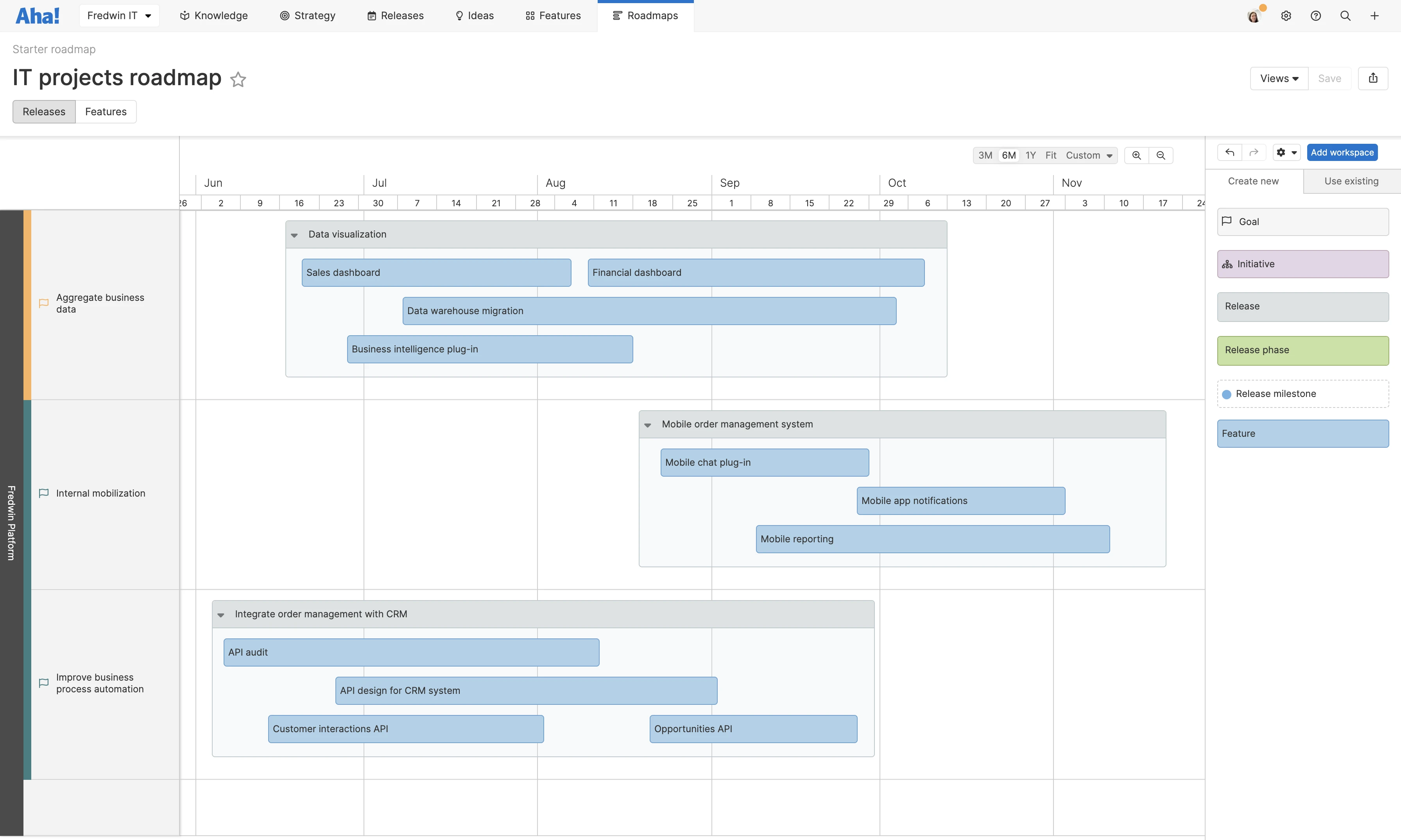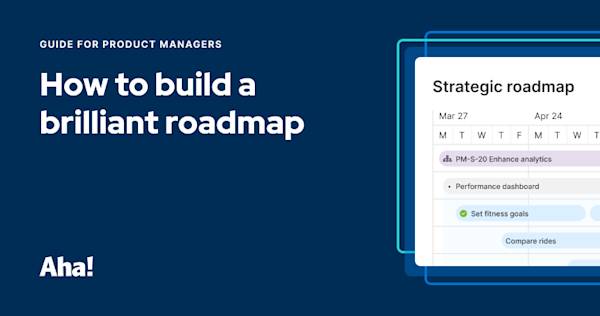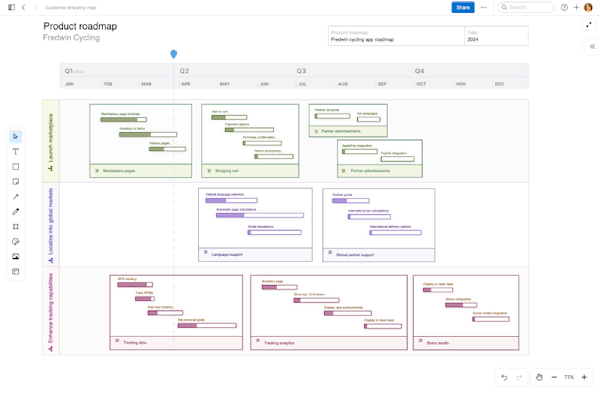IT team roles, collaboration, and business value
Last updated: April 2025
Nobody saves the day like the IT team. Whether you are troubleshooting a critical outage or helping someone recover a lost file, IT professionals are the go-to for solving problems fast. But your work goes far beyond support — you also manage systems, secure infrastructure, and help the business make smarter decisions.
IT teams implement essential tools and lead complex initiatives that shape how organizations function and evolve. Your work drives measurable outcomes, such as reducing risk or enabling more efficient workflows across the business.
Align IT work to business goals with Aha! software. Sign up for a free trial.
IT teams deliver solutions that influence an organization's success. And they are increasingly doing it with a product management mindset. By working with product managers to create roadmaps for internal tools, IT teams can help solve business problems and ultimately achieve critical business initiatives like digital transformation.
Depending on an organization's size, the chief information officer (CIO), chief technology officer (CTO), VP of information technology, or IT director typically leads the IT department. It might include engineers, operators, systems architects, analysts, product managers, and project managers.
This guide covers the structure of IT teams, how you collaborate across the business, and the value you deliver every day.
Jump ahead to any section:
How do IT teams create business value?
IT teams contribute in visible and invisible ways — from supporting day-to-day operations to driving companywide transformation. The most impactful IT teams align their work with business goals and take a proactive role in facilitating long-term success. Here are a few key ways IT teams add to the value of an organization:
IT-business alignment: Connecting technology investments directly to business strategy to drive measurable outcomes
Security and compliance: Reducing risk by identifying threats early and maintaining strong security practices
Communication: Managing digital communication systems and supporting collaboration across the organization
Technical support: Solving technology issues quickly and helping teams get the most out of available tools
Productivity: Recommending and implementing tools that remove friction and improve how people work
Innovation: Introducing new solutions that help the company respond to change and stay ahead
What are the main functions and roles within an IT team?
IT can take the form of any technology that teams within an organization use to get their work done. That includes hardware, software, and computer systems as well as the infrastructure (networks, data storage, memory, etc.) needed to maintain those systems.
While team structure varies by company size and complexity, most IT organizations are grouped by area of expertise. Each team focuses on a specific domain, such as networking or software development, and may report to a dedicated IT manager or share leadership across functions. Here's a breakdown:
Team | Primary responsibility | Typical roles |
IT architecture | Designing systems and infrastructure to support long-term strategy and reduce risk | Chief enterprise architect, solution architect, network engineer |
Networking | Monitoring and managing connectivity systems like LAN, WAN, and firewalls | Network architect, network engineer, systems administrator |
Infrastructure | Overseeing physical and cloud-based systems that support connectivity, system access, and data availability | Database administrator, data warehouse specialist, hardware technician |
Information security | Protecting sensitive data, preventing breaches, and ensuring compliance with regulations | CISO, cybersecurity specialist, cloud security architect |
Engineering and QA | Developing and testing software used internally or by customers | Full-stack developer, QA engineer, software architect |
IT support | Resolving technical issues and providing assistance across the organization | Tier 1–3 support specialist, IT technician, help desk analyst |
Business intelligence | Analyzing and interpreting data to support better decision-making | BI analyst, data analyst, business analyst |
AI and automation | Integrating AI tools and automating workflows to improve efficiency and reduce manual work | AI engineer, machine learning specialist, automation architect |

An example of an IT team's projects roadmap visualized in Aha! software
Team structures may be more fluid at smaller organizations. One person might own responsibilities that span multiple areas — like a systems administrator who also manages network security or a developer who supports infrastructure setup. But roles and teams evolve as business needs change even at larger companies. The key is ensuring responsibilities are clearly defined and aligned with strategic goals.
Related:
How does IT collaborate with cross-functional teams?
Across the organization, teams depend on IT. For instance, HR needs reliable tools to communicate, and business operations relies on secure data access. Your work underpins how others get their jobs done.
While collaboration happens across many departments, IT often works most closely with development and product teams. These partnerships are essential to delivering reliable systems and building technology that supports business growth.
How IT supports development teams
Infrastructure and tooling: Maintain development environments, continuous integration and continuous delivery (CI/CD) pipelines, and cloud resources
Incident response and support: Collaborate on troubleshooting, monitoring, and performance optimization
Process alignment: Coordinate agile workflows, sprint planning, and DevOps practices
How IT collaborates with product teams
Aligning on technology needs: Ensure IT infrastructure supports product management tools and planning workflows
Security and compliance: Protect product data and ensure alignment with regulatory requirements
Supporting innovation: Provide technical feasibility insights for new ideas in the early stages of product development
Close collaboration with development and product teams helps ensure technical decisions support the business. When IT is involved early and often, the work is more efficient and more impactful.
No matter how your IT team is structured, it is important that each group's work is aligned with broader IT goals and company strategy. IT increasingly plays a critical role in driving innovation and elevating the customer experience. Aha! Roadmaps can help you connect day-to-day work to long-term plans — so everyone moves forward with clarity.
FAQs about IT teams
Information technology (IT) refers to the systems and tools used to store, process, and exchange data within an organization. This includes hardware, software, networks, and infrastructure. IT teams manage these resources to help the business operate efficiently and securely.
IT teams maintain infrastructure, support technical operations, and ensure systems are secure and reliable. But their role goes beyond just keeping things running. Many teams also lead strategic initiatives that improve how the business works (such as digital transformation or system modernization). IT is becoming a key driver of innovation at many organizations, helping teams deliver better experiences to customers. Some IT organizations use purpose-built tools like Aha! software to align technical projects with business goals and track progress across teams.
IT teams manage the systems that support day-to-day business operations, whereas software development teams focus on building new applications or features. The two often work closely together: IT ensures the infrastructure is in place, and development teams build on top of it. Tools like Aha! software can help both groups stay aligned by centralizing strategic plans and project timelines.


